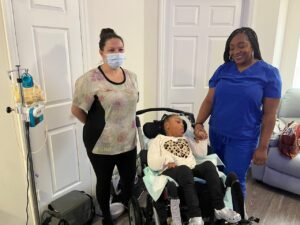Women play a major role in caregiving—whether that is being a primary caregiver for a loved one in need, a professional home health aide, or a skilled nurse tasked with providing the care needed by someone who needs consistent, ongoing care. Women have consistently been the cornerstone of caring for America’s vulnerable populations, proving to be the strength of our caregiving system at every stage of life. And although we have made huge strides, our healthcare system currently has serious supply and demand issues which will only worsen if lawmakers don’t start properly investing in this critical labor force.
Women make up over 87% of the American nursing workforce — and nearly 90% of the skilled nurses that work in home care. And with so many medically-fragile individuals that prefer to receive care at home, I ask, why is the home care nursing workforce so often overlooked?
When we think of nurses, we often picture a nurse in a hospital, or perhaps even in a facility like a nursing home or long-term rehab. But the truth is, millions of Americans are now able to access skilled nursing care at home. And that’s the way it should be, since medical advancements and longer lifespans mean that healthcare facilities are no longer the “default setting” for those in need. Babies born with medical complexities can now be discharged out of NICUs to live at home alongside their parents, and adults and seniors are often transitioned from hospitals and nursing homes with an authorization for home nursing ─ producing better patient health outcomes and proving cheaper than facility-based care.
But there is a major problem: Our state and federal governments continue to underprioritize in-home care. The majority of in-home nursing is funded by state Medicaid programs, and these programs are woefully underfunded. As a result, there are not enough nurses in home care to keep up with demand. Nurses are routinely attracted to jobs in hospitals and other facilities where they can earn significantly more in wages and are offered large sign-on bonuses, leaving individuals and families simply unable to access this form of care. And when in-home care is not available, family members must often call out of work, lose sleep, or even forego working altogether to care for their loved one. All too often, it also means that they may have to consider putting that family member into a costly long-term facility in order to access reliable healthcare services.
Until our state governments can catch up and equalize funding for in-home nursing, our nation’s most medically-fragile will continue to struggle to access care in their homes.
The home care nursing workforce shortage may not affect you personally at this moment—but there is no doubt that it will touch your life at some point. Baby Boomers are aging, and predictions show that 95 million Americans will be 65 years and older by the year 2060 ─ drastically increasing the need for long-term care. But as inflation, cost-of-living, and wages in the private sector are increasing, even the nurses that love providing one-on-one care in the home are leaving home care to do the same work in facilities while better providing for their families. While state Medicaid programs are increasing funding for home care programs incrementally, it’s just not enough to keep up.
It is long overdue for women and all in-home nurses to be appropriately recognized, appreciated, and compensated for the difficult and empathetic work they do in caring for America’s medically-fragile populations. During this year’s Women’s History Month, I ask our lawmakers to begin take this problem seriously by investing in home care programs. At the end of the day, how do we intend to care for the US’s most vulnerable populations in their own homes, if the nursing workforce expect to provide that care isn’t there?

Cris Toscano
Practice President of Skilled Nursing at BAYADA Home Health Care







